KOMBUCHA Is Here!
By Alice Osborne
I hang out at natural foods stores almost weekly, wandering and pondering on the products found and the benefits these products offer. One product that's caught my eye is a drink called kombucha. Ever heard of it?

Research says this beverage promotes health by giving the body what it needs to heal itself. It's filled with living probiotics that aid the liver in removing harmful substances. It promotes balance in the digestive system and is rich in health-promoting vitamins, enzymes, and acids.
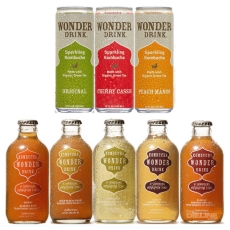 Kombucha is the liquid darling of health food gurus now, and lots of brands are popping up all over. Example: Wonder Drink, which appeared in 2001. It's creator, Steve Lee, got a culture for it when he was in Russia and started brewing it at home. This brand has low amounts of sugar and is pasteurized to ensure the absence of alcohol, and is certified organic and labeled gluten free. (BTW: Are there actually drinks that contain gluten? I need to check this out—this claim seems like nothing more than advertising hype to me, but maybe not. I'll report back on this.)
Kombucha is the liquid darling of health food gurus now, and lots of brands are popping up all over. Example: Wonder Drink, which appeared in 2001. It's creator, Steve Lee, got a culture for it when he was in Russia and started brewing it at home. This brand has low amounts of sugar and is pasteurized to ensure the absence of alcohol, and is certified organic and labeled gluten free. (BTW: Are there actually drinks that contain gluten? I need to check this out—this claim seems like nothing more than advertising hype to me, but maybe not. I'll report back on this.)
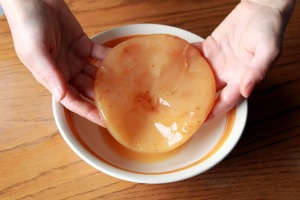 OK, but back up. "Kombucha culture?" What's that? Wikipedia says it's a symbiotic colony of bacteria and yeast. The acidity and mild alcoholic element of kombucha resists contamination by most airborne molds or bacterial spores. As a result, kombucha is relatively easy to maintain as a culture outside of sterile conditions. The bacteria and yeasts in it promote microbial growth. Chemical analysis of kombucha suggests glucuronic acid is the key component, and researchers say the extra glucuronic acid assists the liver by supplying more of the substance during detoxification.
OK, but back up. "Kombucha culture?" What's that? Wikipedia says it's a symbiotic colony of bacteria and yeast. The acidity and mild alcoholic element of kombucha resists contamination by most airborne molds or bacterial spores. As a result, kombucha is relatively easy to maintain as a culture outside of sterile conditions. The bacteria and yeasts in it promote microbial growth. Chemical analysis of kombucha suggests glucuronic acid is the key component, and researchers say the extra glucuronic acid assists the liver by supplying more of the substance during detoxification.
So following the Wonder Drink creator's lead, you can brew your own at home (good thing, because this drink can retail anywhere from $2 to $5 or more per container.) Kombucha is typically produced by placing a starter culture in a sweetened tea, as sugars are necessary for fermentation. Black tea is a popular choice, but green tea, white tea, and yerba mate may also be used. (Herbal teas or those treated with oils may harm the kombucha culture over time.)
But where do you get a kombucha culture? I couldn't find any information on creating your own (although I bet it's possible). So it looks like you buy one. I called every natural foods store I could think of asking if they sold kombucha starter and was told "No we don't" in every instance. But I did find 2 highly recommended sites that sell this:
- www.GetKombucha.com ($26.97—folks like this company because the starter package is larger than a CD and about 1/2-inch thick. The reviewers all said that other companies sell for less, but you get far less product as well.) This site provides how-to videos and quick response to your questions.
- www.culturesforhealth.com (starter for $11.99 or a starter kit for $21.99, which includes enough organic black tea for the culture activation batch, a 4-inch plastic mesh strainer, 10 pH Strips, and a 16-page instruction booklet that includes bottling and flavoring ideas. This site also offers a free 130 page ebook with 27 recipes.)
A standard kombucha recipe calls for one cup of sugar per gallon of water or tea, though some variation in the ratio is tolerated by the culture. Kombucha may be fermented with many different sugar sources, including refined white sugar, evaporated cane juice, brown sugar, glucose/fructose syrups, molasses and honey (pasteurized only). Note: High concentration of honey and its bacteriostatic agents may potentially disturb the stability of the culture. Finally, kombucha should never be fermented with stevia, xylitol, lactose, or any artificial sweetener.
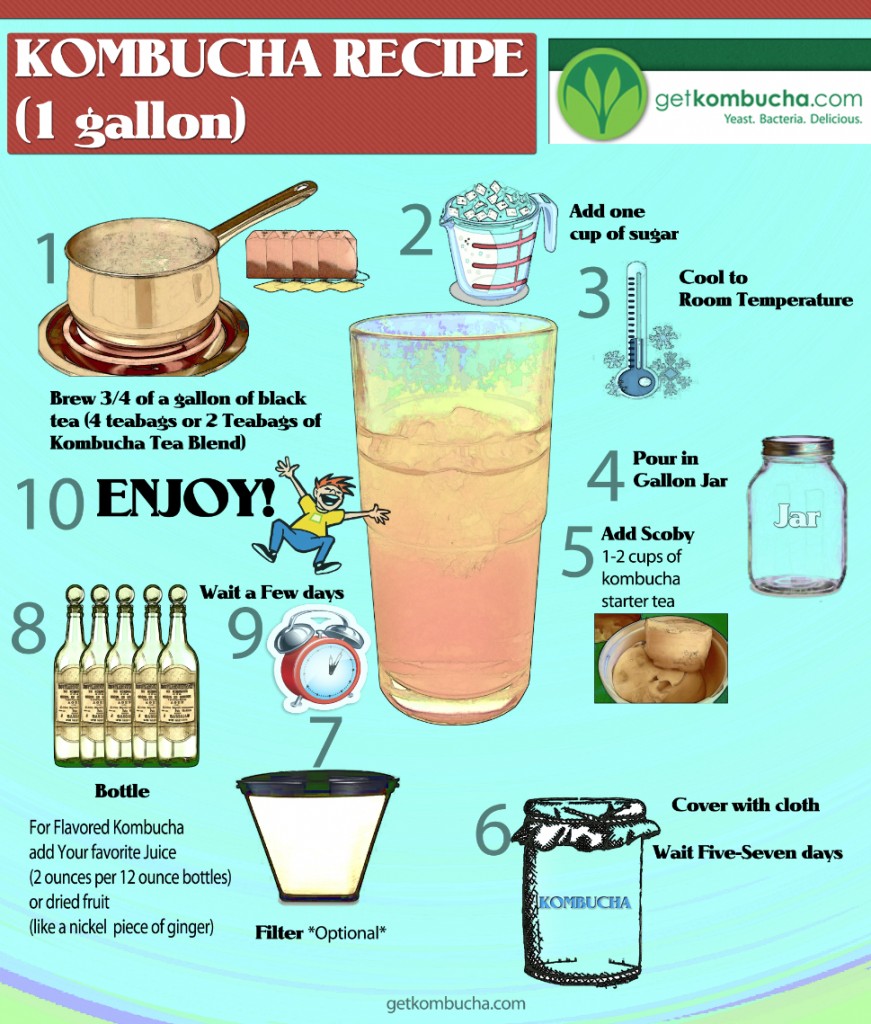
On foodrenegade.com I found this recipe with great how-to instructions and pictures (see below).
I'm intrigued for sure, but before I launch into a full-scale manufacturing of this drink, I'll start out by buying a few bottles at my natural foods store and see how I like it, and how I feel after drinking it for awhile. Then I may jump on the homemade kombucha bandwagon—I'll report back.
Kombucha
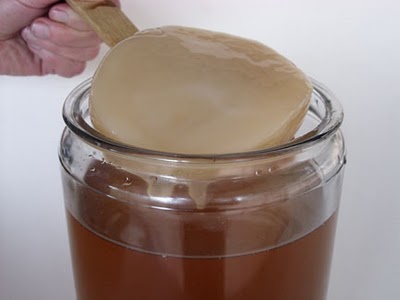
A probiotic- and enzyme-loaded drink with the zing of soda pop!
"First - assuming you didn't grow your own scoby, you've got a week to ten days to start this process from the day you receive the kombucha starter or "mother" to ensure the freshest and most healthful product. If you let the mother sit too long in your refrigerator it will make the kombucha stale.
"Second - each mother comes with at least a half a cup of liquid with it. That is important stuff, so do not pour it off. You'll actually use that in your first batch of tea. I recommend buying a bottle of Kombucha from the health food store to help your first batch, but this isn't needful. If you choose to do it, you'll want to buy Organic Raw Kombucha without any fruit sweeteners added.
"Finally - the starter is a bit strange and takes some getting used to. Handling it and placing it on top of the tea just takes a little practice and a sense of adventure, but is pretty disarming initially.
"One final note - EVERYONE will tell you something different. Brewing kombucha is just like making any other dish. There are hundreds of variations and recipes out there, each one somebody's favorite. Everyone will swear doing this or that particular thing will make the beverage more healthful for you - and often the advice is contradictory. My point? Relax. Just do it. Enjoy it. Experiment and see what works for you!
2 gallons sweetened tea
2 kombucha mothers , (AKA "scobies" or "mushrooms")
2 large gallon glass jars
1 thin kitchen towel
15 ounces fruit juice , (your choice of flavor)
6 quart-size jars with lids (any size bottle or jar will do, so long as you’ve got enough to hold 75%-80% of your brewed kombucha)
Directions:
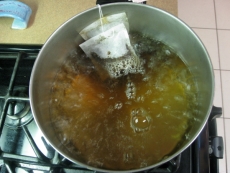 Boil about 2 gallons of fresh, filtered water on the stove top. Once water is at a full boil, remove from heat and add tea bags or family-sized tea bag and steep for 5 minutes. You can use inexpensive, plain Lipton tea for this, or experiment with other black or green teas as you desire.
Boil about 2 gallons of fresh, filtered water on the stove top. Once water is at a full boil, remove from heat and add tea bags or family-sized tea bag and steep for 5 minutes. You can use inexpensive, plain Lipton tea for this, or experiment with other black or green teas as you desire.
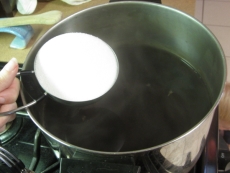 Remove tea bags and add 2 cups of sugar, stirring vigorously until it is dissolved. (This is the only thing in my house we use refined sugar for. We tried brewing kombucha with natural sweeteners like sucanat, honey, or agave nectar, but they all made the final brew take longer and taste sour. There’s no need to fear this refined sugar because it’s basically just food for the yeast.) Let the sweetened tea sit on the stove top until it has cooled to room temperature. This usually takes about 2 hours.
Remove tea bags and add 2 cups of sugar, stirring vigorously until it is dissolved. (This is the only thing in my house we use refined sugar for. We tried brewing kombucha with natural sweeteners like sucanat, honey, or agave nectar, but they all made the final brew take longer and taste sour. There’s no need to fear this refined sugar because it’s basically just food for the yeast.) Let the sweetened tea sit on the stove top until it has cooled to room temperature. This usually takes about 2 hours.
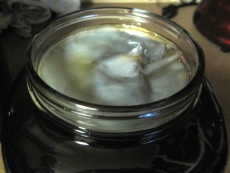 Carefully place the mother on top of the tea mixture.
Carefully place the mother on top of the tea mixture.
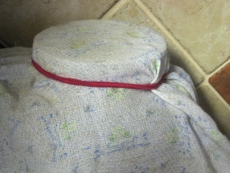 Cover your glass containers with a clean kitchen towel and place away from direct sunlight. I secure the towel with large rubber bands. The kombucha needs oxygen to ferment, so you’re using a towel rather than a lid to allow air to circulate. The rubber band secures the towel to keep out flies, insects, or other contaminants.
Cover your glass containers with a clean kitchen towel and place away from direct sunlight. I secure the towel with large rubber bands. The kombucha needs oxygen to ferment, so you’re using a towel rather than a lid to allow air to circulate. The rubber band secures the towel to keep out flies, insects, or other contaminants.
(Allow starter/mother to “eat” the sugar and produce acids & enzymes.) You will allow the tea mixture to set out in the dark corner of your kitchen for 5 days. You can forget about it or you can peek. Either way on the morning of day 5, remove the mother and set it aside on a plate, pouring about a half cup of the fermented tea mixture over the mother to keep it moist. Put it in the refrigerator. Every other batch or so, you’ll be able to separate the old mother from its “baby” which will have grown on top of the old mother. (It may separate on its own, or you may just pull them apart.) When that happens, the baby will become the mother for your next batch of kombucha tea. The “old” mother can be passed on as a gift or discarded.
(Allow kombucha to ferment with juice for a tasty finish.)
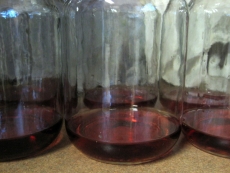 Pour clear fruit juice (no pulp, it causes much stringy nastiness!) into the smaller glass jars or bottles you’re using to bottle your kombucha. I use about 2.5 oz. of fruit juice per quart-sized jar. You can use any size bottle or jar, just be sure to adjust the fruit juice accordingly. You’re looking at a cranberry apple juice blend.
Pour clear fruit juice (no pulp, it causes much stringy nastiness!) into the smaller glass jars or bottles you’re using to bottle your kombucha. I use about 2.5 oz. of fruit juice per quart-sized jar. You can use any size bottle or jar, just be sure to adjust the fruit juice accordingly. You’re looking at a cranberry apple juice blend.
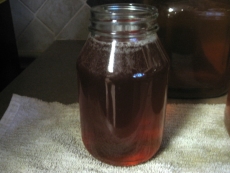 Pour kombucha tea on top of the fruit juice, allowing about an ounce of breathing room at the top of the bottle, close bottle tightly. Be sure to save at least 10% of your brewed kombucha to use with your saved mother in your next batch. To ensure a consistent brew, I save about 25% of mine.
Pour kombucha tea on top of the fruit juice, allowing about an ounce of breathing room at the top of the bottle, close bottle tightly. Be sure to save at least 10% of your brewed kombucha to use with your saved mother in your next batch. To ensure a consistent brew, I save about 25% of mine.
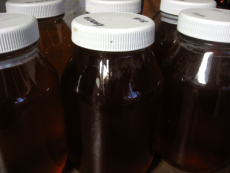 Place bottles back in your ‘fermenting place’ for 48 hours and cover with a kitchen towel so they avoid exposure to direct sunlight.
Place bottles back in your ‘fermenting place’ for 48 hours and cover with a kitchen towel so they avoid exposure to direct sunlight.
Day 5 / Part Three: Begin Your Next Batch: “Repeat the process for Day 1, Parts One and Two, and use the mother you set aside earlier as the mother for this batch of kombucha tea.
Day 7 : Finish: “Put bottles in the refrigerator and chill completely before opening. Do not shake. When you open, remove the thin film of new “mother” that accumulated on top during the fruit juice fermentation phase. Contents will be bubbly. Enjoy the fruits of your five or ten minutes of labor.
Some Final Notes: “Periodically, you may notice your kombucha changing flavor in a way you don’t like. When that happens, I usually add a bottle of Organic Raw Kombucha into my fermenting sweetened tea to restore the balance to the yeast and bacteria. [Alice: If you don’t want to do that, www.foodrenegade has a helpful index for “fixing” problems with your kombucha culture.]
“Also, your kombucha mother may turn brown, or bubbly, or do all sorts of strange things. None of these are problems. The only thing you want to really look out for is mold, and if it molds it will look like the mold on bread – fuzz and all.
“These instructions are assuming that the room temperature where you’re brewing your kombucha is around 75 degrees. (I’m in Texas, what can I say?) If the temperature is considerably warmer than this, it will take less time to ferment. If it is considerably cooler than this, it will take more time to ferment. As such, people find that during the winter in cooler climates they may let their kombucha ferment for up to a week longer than they do during the height of summer. How can you tell when your kombucha’s ready to be bottled with fruit juice? When it’s mildy sweet and mostly tart.”
Recipe formatted with the Cook'n Recipe Software from DVO Enterprises.
- www.utahfindit.com
- www.dieline.com
- www.organicsoul.com
- www.getkombucha.com
- www.threehundredandsixtysix.wordpress.com
- www.theobviousobserver.blogspot.com
- www.foodrenegade.com

Alice Osborne
Weekly Newsletter Contributer since 2006


